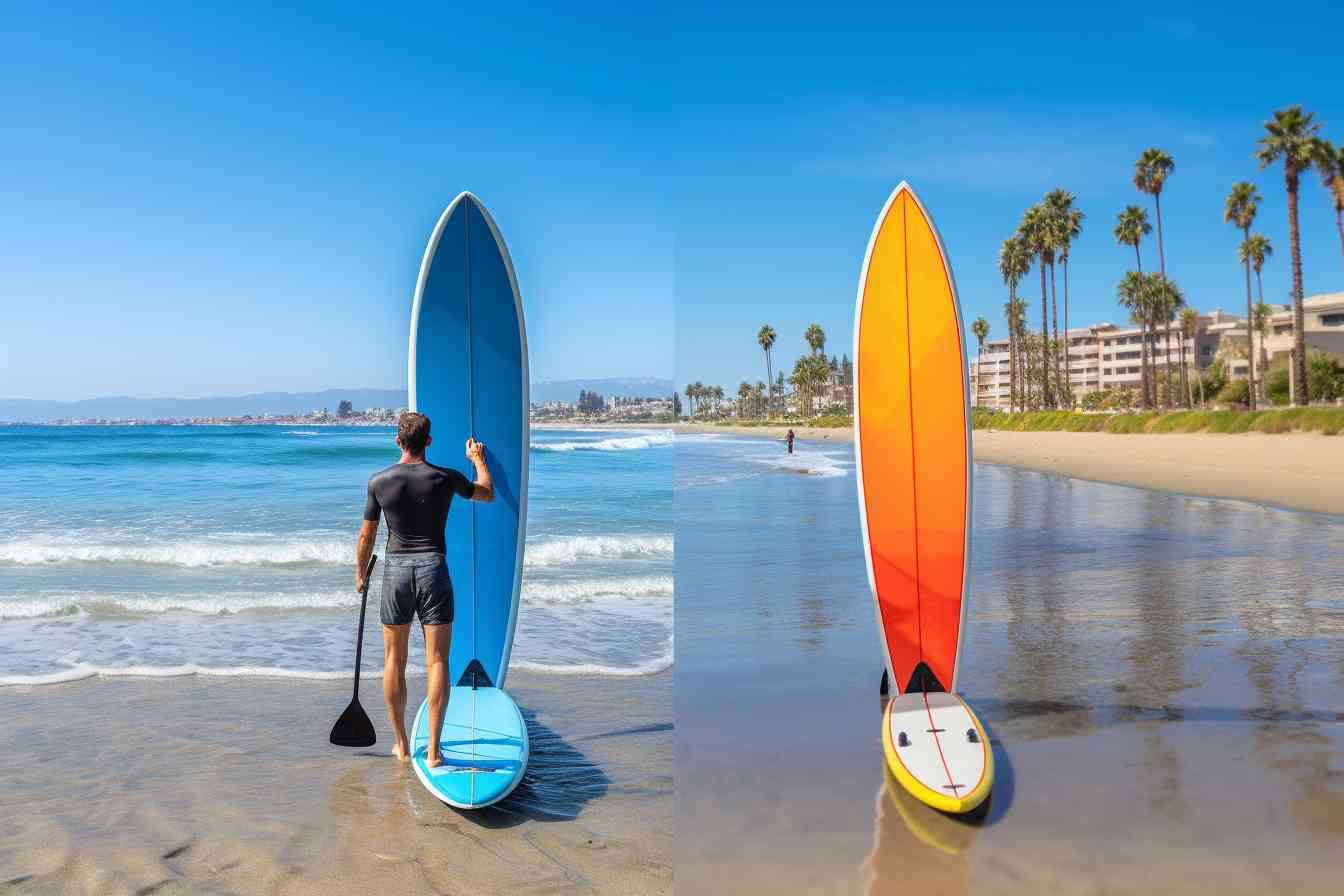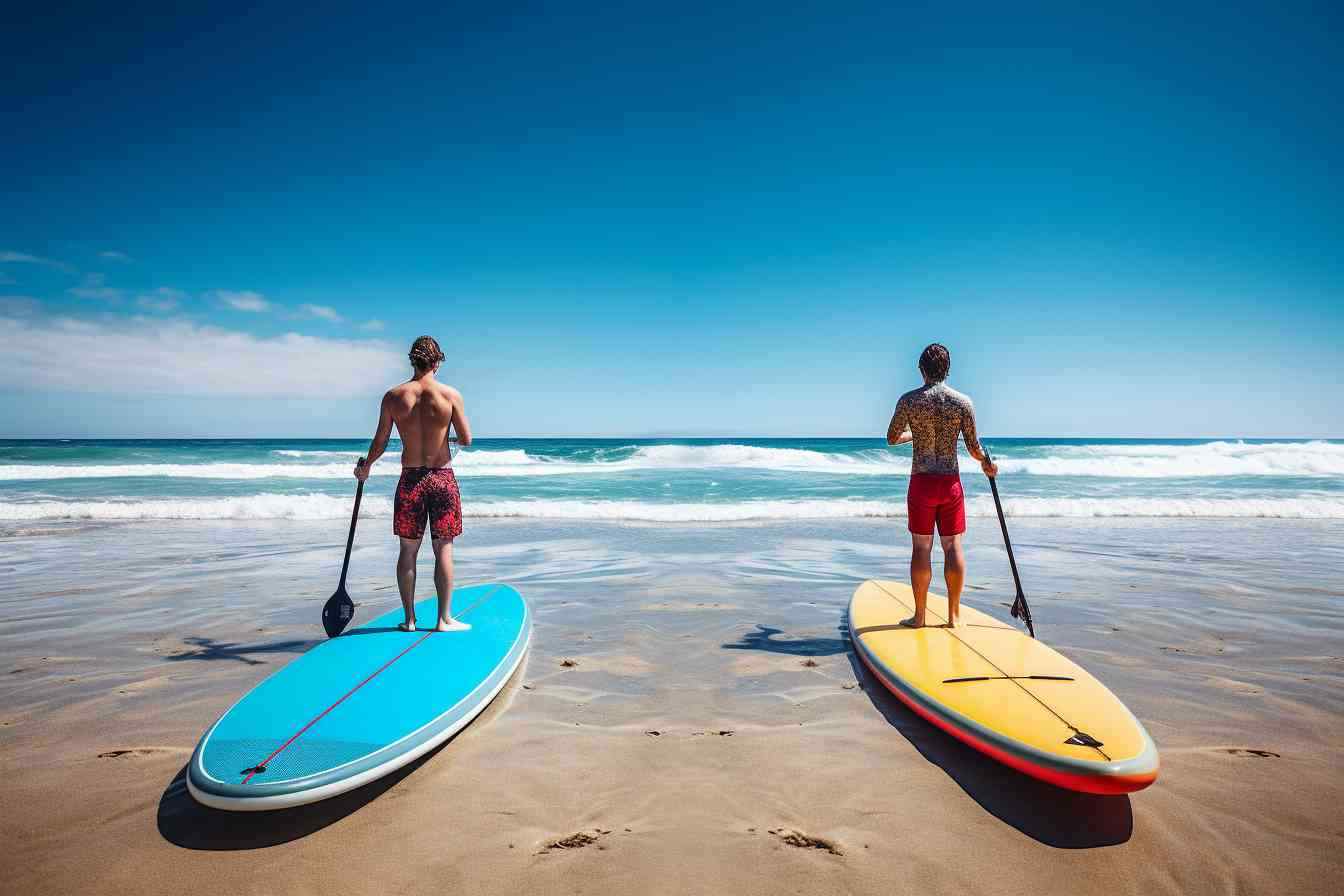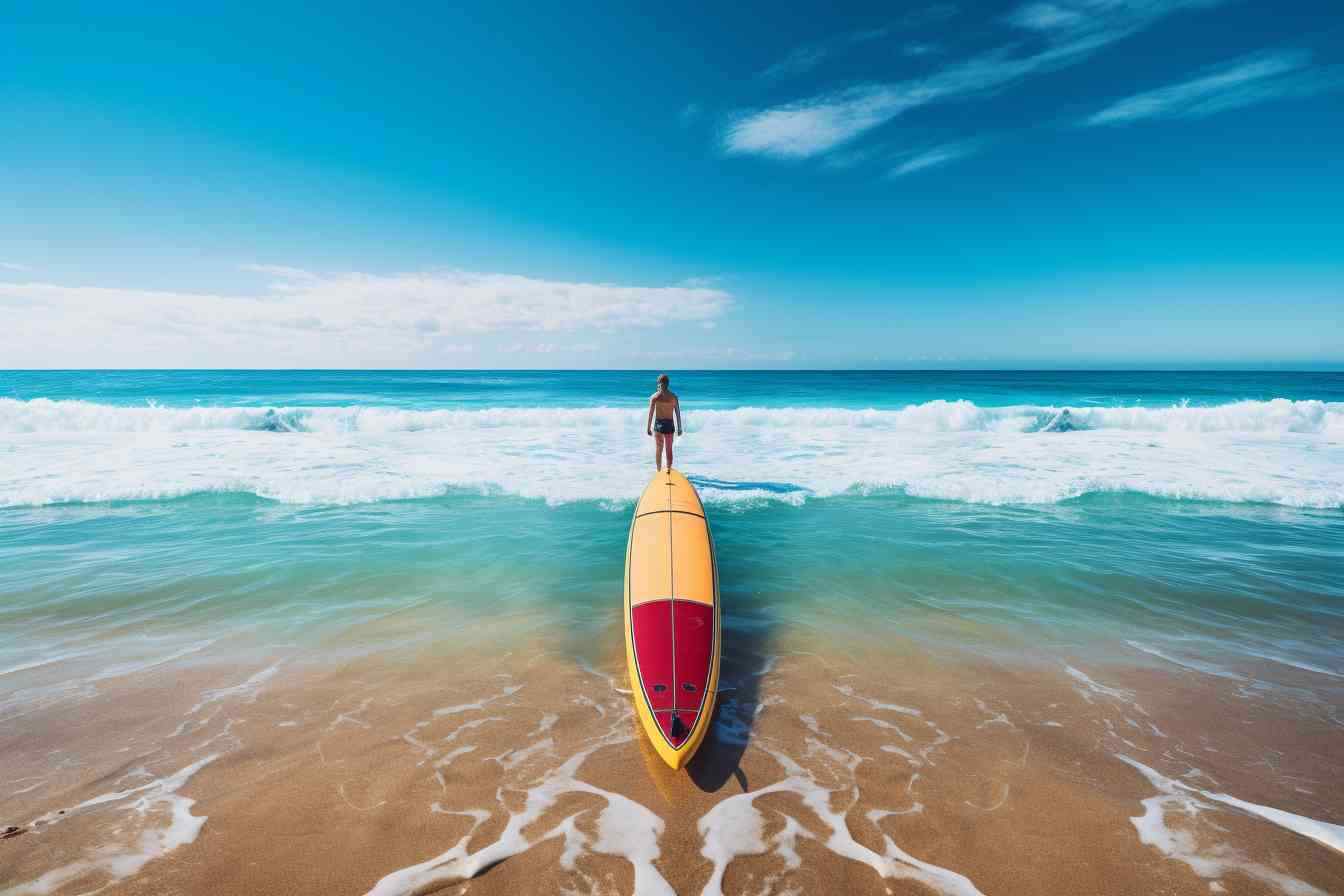Battle of the Waves SUP vs Surfboard Unleashing the Truth

Summary
- Intro: Sup Vs. Surfboard: What’S The Difference?
- What Is The Difference Between A Surfboard And A Sup Board?
- Can I Use My Sup As A Surfboard?
- Is It Easier To Surf Or Paddle Board?
- Can You Surf With Regular Sup?
- Final Verdict
- Frequently Asked Questions
- What’s the main difference between SUP and surfboards?
- Can you surf with a SUP?
- Is a SUP or surfboard better for beginners?
- Which one gives you a better workout, SUP or surfboard?
- How do the cost of SUPs and surfboards compare?
- Can kids use SUPs or surfboards?
- What’s the best for flatwater, SUP or surfboard?
- How do storage and transportation differ between SUPs and surfboards?
- Do SUPs and surfboards require different skills?
- How versatile is a SUP compared to a surfboard?
- Do I need lessons to start with a SUP or surfboard?
- Related Video
- Frequently Asked Questions
Intro: Sup Vs. Surfboard: What’S The Difference?

Oh boy, this is one of those conversations that can fire up an ocean lover faster than a jet ski. Think of SUPs and surfboards as siblings, same aquatic DNA, but each with their very own bag of tricks, you know? Now, a SUP, or Stand Up Paddleboard, is like the multitasker of the family—they’ve got that “I’m chill but I can do it all” vibe going on. Balancing on these beauties, you’ve got a paddle to navigate the waters. It’s a full-body engagement, working your core and arms as you glide over the surface. Stability is their middle name, with their wide platforms making it a bit easier for beginners to get the hang of.
Now flip the coin and you’ve got surfboards. They’re the daredevils; lighter, narrower, and let’s just say they have a need for speed. Riding these waves requires a bit more agility and balance but man, when you catch that wave, it’s pure adrenaline. Surfing feels like a dance with the ocean – a little give, a little take – and there’s nothing quite like the thrill of that perfect ride. People might think it’s a bit daunting at first, given the smaller surface area, but once you get the knack, it’s like nothing else on earth. Each board has its charm and choosing between the two? Well, it all boils down to what kind of spice you’re looking for in your aquatic adventures!
What Is The Difference Between A Surfboard And A Sup Board?

Oh boy, let me dive right into the nitty-gritty of what sets these two wave-riders apart! When I’m out there on the water, or just chatting with folks who wanna catch some waves, the difference between a surfboard and a SUP board can stir up quite the debate.
Surfboards, man, they’re sleek as dolphins and built for a rush. They thrive when the rider paddles out, waits for the perfect swell, and pops up to ride the face of the wave. It’s all about agility, balance, and a bit of bravado, if you ask me. But here’s the kicker—the size and shape of the surfboard – it’s a big deal! A longer board might give you a smooth glide, while a short, stubby one promises some rad maneuvers.
Now, shift gears to a SUP board—it’s like the long-lost big brother of surfboards. SUP stands for Stand Up Paddleboard, and it’s exactly what it sounds like. You’re standin’ tall, paddle in hand, and you’ve got a different kind of ball game. SUP boards are wider, thicker, and, well, more buoyant which makes them a dream for stability. They’re the go-to for a serene day on the lake or adding an angle to your fitness routine. Didn’t think you could do yoga on water? Think again!
So, picture this: while a surfboard is like a nimble sports car, zipping and cutting through the waves, a SUP board? It’s your comfortable SUV – spacious, versatile, and ready for a variety of adventures, from racing to touring, or even fishing. I gotta say, both have a sweet spot in my heart, but each serves a whole different thrill on the water.
Can You Use A Surfboard As A Paddleboard
Well, I’ve seen quite a few folks out on the water getting creative with their gear, but let’s dive into the nitty-gritty of whether you can actually use a surfboard as a paddleboard, shall we?
- While surfboards and paddleboards might look like distant cousins, using a surfboard as a paddleboard is kinda like trying to ride a bike underwater – you might make it work, but it’s not what it’s made for. Surfboards are designed to catch waves with their sleek and narrow shape, which means they’re typically less stable than paddleboards when you’re trying to stand up and paddle on flat water.
- Now, I’m not saying it’s a complete no-go – enthusiastic paddlers without a SUP might attempt to use a larger, more buoyant surfboard as a makeshift paddleboard, but beware; balance will be your biggest challenge.
- Believe it or not, even though the surface area on the top of a surfboard seems ample, it’s not typically designed to support the standing weight and movement that comes with paddling. You’ll find the sweet spot for standing is much smaller – good luck finding your equilibrium!
- Another thing to consider is the volume of the board. SUPs have a higher volume, giving them more buoyancy. A surfboard might dip and dive under your weight, turning your paddle session into a dunk tank experience.
- Oh, and let’s talk about that paddle. Unless you’ve got arms like an octopus, you’re going to find the average surfboard’s lack of length a real stretch – literally – when it comes to effective paddling. SUP paddles are taller for a reason, folks.
- Curiously enough, some surfboards come with grip pads on the back, but that’s where the similarity to SUPs ends. Those pads help surfers to maneuver on the waves, while a SUP’s entire top deck is often padded for comfort and stability while standing for extended periods.
- Lastly, fins. Surfboards have ‘em and so do SUPs, but the setup can be as different as chalk and cheese. Surfboards have fins optimized for cutting into waves, while SUP fins help with straight-line stability – super important when you’re paddling on calm waters.
- And I gotta mention, if your surfboard has a leash plug, it’s meant to keep that board close when you wipe out on a wave. On a SUP, it’s more about safety, keeping the board close if you fall off so it doesn’t become a runaway hazard.
Can I Use My Sup As A Surfboard?

Well, that’s quite the question, isn’t it? Simply put, a SUP (stand-up paddleboard) and a surfboard are like cousins in the aquatic sports family. They share some features but have their own unique traits. A SUP might look like an oversized surfboard, but they’re designed for stability and glide on calm waters when you’re upright and paddling. Now, don’t get me wrong, some daring souls do indeed use SUPs on the waves, catching them much like you would with traditional surfing. However, there’s a catch.
The SUP’s generous size and shape, though perfect for balance when you’re cruising on a lake or a quiet sea, make it noticeably cumbersome in the dynamic surf environment. Surfboards, on the other hand, they’re sleek, streamlined, and made to cut through waves with the agility of a sea otter. They respond quickly to shifts in body weight and wave dynamics, crucial for maneuvering and carving up the face of a wave.
I’ve seen folks out there giving it a go, using their SUPs in the surf, and it’s a sight. But honestly, I shake my head a little every time. It’s akin to taking a long, leisurely stroll in high heels – it’s possible, but boy oh boy, not the most effective choice. Surfboards, they’re like your trusty sneakers made for the sprint. Plus, if you’ve got folks around you on proper surfboards, you might just feel a little out of place with the extra heft of a SUP. Just something to ponder before diving in!
Is It Easier To Surf Or Paddle Board?

Oh man, talk about a debate that’ll catch any wave lover’s attention – the classic toss-up between surfing and SUP (Stand Up Paddle boarding). So here’s the lowdown: it’s like asking whether it’s easier to salsa or tango. Each has its groove and rhythm.
Surfing, that’s like dancing with the ocean, right? You’re waiting for that perfect wave, paddling like mad to catch it, and then – whoa – you’re flying down the face of it, heart pounding. It’s an adrenaline rush for sure, but let me be real with you, it’s not a cakewalk. Those gnarly waves can be unforgiving, and finding your balance on a thin board is no joke. You need some serious skills, and there’s usually a pretty steep learning curve.
Now, paddle boarding? That’s a different kettle of fish. It often starts smoother than a morning latte. You stand on a wider, more stable board, and with a paddle in hand, you’re the master of your own path – no need to wait for waves. On a calm day, it’s almost like taking a leisurely stroll on water. Sure, your core’s getting a workout, but the vibe? It’s more chill, more accessible for newbies.
Both are killer workouts and totally rad in their own right, but if you’re gunning for an easier start, SUP might just be your jam. Just remember, easier doesn’t always mean easy – keep that in mind, dudes and dudettes. And hey, don’t forget to respect the ocean, she’s full of surprises. Keep paddling or shredding, and soon enough, you’ll be owning whichever you choose.
Can You Surf With Regular Sup?
Oh boy, let me dive right into this! So, can you surf with a regular SUP (stand-up paddleboard) or is that like trying to teach a fish to walk? Well, it’s not that far-out an idea! Paddling into waves with a SUP is actually a thing—and quite the thrill, if I might add! The SUP’s larger size and volume make it a stable platform, which is fab when you’re looking to catch and ride smaller waves.
Now, let’s be real — a SUP isn’t going to give you the same gnarly experience as a surfboard when it comes to shredding those big curls. Just think about the agility; surfboards are like sportscars, cutting through the water, while SUPs are more like your comfy SUVs. But hey, don’t knock it till you’ve tried it! Riding waves on a SUP requires a different technique, where balance and paddle skills take center stage. So, if you’re up for a challenge, and wanna feel the stoke of surfing in a different way, definitely give it a whirl! Just be mindful that it’s a different ballgame and respect the lineup — those surfers can get quite territorial.
Final Verdict
Oh boy, this one always gets the waters churning. Paddleboarding and surfing are like distant cousins who only see each other at family reunions but have wildly different stories to tell. Each has its own charm, and choosing between ‘em really boils down to what floats your boat – or board, in this case.
Alright, here we go with the final verdict. It’s like trying to pick your favorite ice cream flavor at that fancy parlor downtown; both are scrumptious but hit your cravings different, y’know? Surfboards, they’re the classic – whisking you across waves with a feeling that’s as old as the ocean itself. It’s just you and the surf, with your heart beatin’ in time with the rolling sea. Pure adrenaline, raw and untamed, baby! But it’s no secret, surfing’s tough on the muscles and asks for some solid skills.
Now, SUPs, on the flip side, are a smidge more laid-back. ‘Course they’ve got their exciting moments but generally speaking, it’s a more chilled-out vibe. Standing atop a SUP, you get this unbeatable view of ol’ Mother Nature’s waterworks, and it’s a fantastic workout that won’t leave you feeling like you’ve wrestled a sea lion. Plus, it’s a tad easier to get your sea legs with a paddleboard underfoot.
So what’s the verdict, you ask? It’s like picking between grilled cheese and pizza – depends on yer mood and what ya’ in the mood for. Surfing’s for the thrill-seekers and the wave dancers, while SUP is your go-to for a serene glide on the water that’ll tone up those abs. Either way, you’re in for a splashin’ good time. Just remember to respect the waves, and they’ll treat ya’ right, whether you’re shredin’ or paddlin’.
Frequently Asked Questions
What’s the main difference between SUP and surfboards?
Ah, well, that’s simple! A SUP, or stand-up paddleboard, is generally wider and thicker, providing a stable platform for you to stand on and paddle around. Surfboards, they’re sleeker and designed for, you know, catching waves and maneuvering with agility on them.
Can you surf with a SUP?
Oh, for sure! You can catch waves with a SUP; it’s pretty awesome actually. But remember, it’s a different ballgame compared to traditional surfing ‘cause you’re standing up and using a paddle. So, yeah, it takes a bit of practice to get the hang of it.
Is a SUP or surfboard better for beginners?
Well, I’d say a SUP might be easier to start with. It’s all about balance, and with its larger size, it gives newcomers more stability, which can be super helpful when you’re just finding your sea legs.
Which one gives you a better workout, SUP or surfboard?
Hmm, both can give you a solid workout. However, SUPs might have the upper hand because you’re constantly paddling, which hits your core, arms, and legs. Surfing, on the other hand, has explosive movements and paddling which is great but with more downtime waiting for waves.
How do the cost of SUPs and surfboards compare?
Ah, the mighty dollar question! Generally, SUPs can be more expensive than surfboards due to their size and the extra gear like paddles and sometimes even a leash. But prices vary widely based on brand, materials, and performance level.
Can kids use SUPs or surfboards?
Absolutely! Kids can have a blast with both. SUPs can be super fun for little ones, especially because they can sit or kneel; it’s quite versatile. Surfboards are cool too but might require a bit more athletic ability and ocean knowledge.
What’s the best for flatwater, SUP or surfboard?
Oh, SUP wins hands down for flatwater. It’s like they’re made for cruising on lakes, rivers, and calm seas. Surfboards are, well, made for the surf, so they just don’t glide as well on flatwater.
How do storage and transportation differ between SUPs and surfboards?
Well, here’s the deal: SUPs are chunkier, so they need more space. If you’ve got a garage or a storage spot, great, but remember, they’re a bit of a bear to transport. Surfboards are slimmer and lighter, so they’re a piece of cake to move around and stow away.
Do SUPs and surfboards require different skills?
Yep, they’re similar but definitely not the same. Paddling on a SUP requires some serious core strength and balance, not to mention you’re using a paddle. Surfing is more about quick movements, like popping up and riding the wave, and playing with gravity.
How versatile is a SUP compared to a surfboard?
I’d say SUPs win in the versatility department. You can use them for a tranquil paddle on a lake, a coastal cruise, or even wave riding. Surfboards are specialists, though: they’re built for the excitement of riding waves, and that’s where they shine.
Do I need lessons to start with a SUP or surfboard?
I’d totally recommend lessons for both, at least to get started. They can help you learn proper techniques and, importantly, how to stay safe out there on the water. No shame in getting a bit of help at the beginning!


Comments